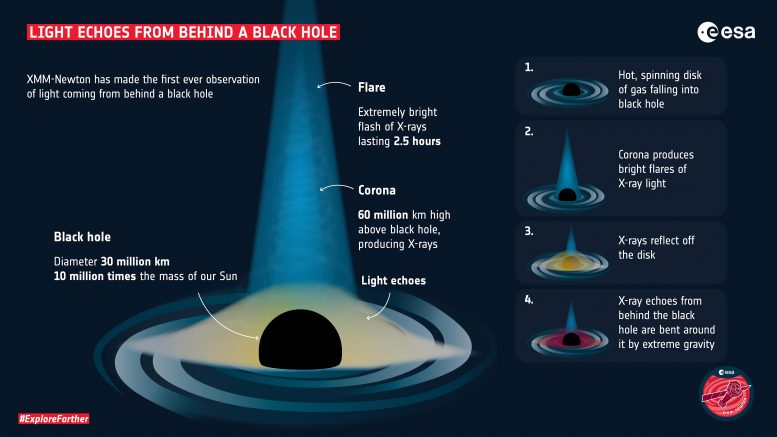Researchers observed bright flares of X-ray emissions, produced as gas falls into a supermassive black hole. The flares echoed off of the gas falling into the black hole, and as the flares were subsiding, short flashes of X-rays were seen – corresponding to the reflection of the flares from the far side of the disk, bent around the black hole by its strong gravitational field. Credit: Dan Wilkins
First Detection of Light From Behind a Black Hole
Watching X-rays flung out into the universe by the supermassive
Illustration of how light echoes from behind a black hole. Credit: ESA
The strange discovery, detailed in a paper published today (July 28, 2021) in Nature, is the first direct observation of light from behind a black hole – a scenario that was predicted by Einstein’s theory of general relativity but never confirmed, until now.
“Fifty years ago, when astrophysicists starting speculating about how the magnetic field might behave close to a black hole, they had no idea that one day we might have the techniques to observe this directly and see Einstein’s general theory of relativity in action,” said Roger Blandford, a co-author of the paper who is the Luke Blossom Professor in the School of Humanities and Sciences and Stanford and SLAC professor of physics and particle physics.
How to see a black hole
The original motivation behind this research was to learn more about a mysterious feature of certain black holes, called a corona. Material falling into a supermassive black hole powers the brightest continuous sources of light in the universe, and as it does so, forms a corona around the black hole. This light – which is X-ray light – can be analyzed to map and characterize a black hole.

Animation showing how light echoes from behind a black hole. Credit: ESA
The leading theory for what a corona is starts with gas sliding into the black hole where it superheats to millions of degrees. At that temperature, electrons separate from atoms, creating a magnetized (function(d, s, id){
var js, fjs = d.getElementsByTagName(s)[0];
if (d.getElementById(id)) return;
js = d.createElement(s); js.id = id;
js.src = "https://connect.facebook.net/en_US/sdk.js#xfbml=1&version=v2.6";
fjs.parentNode.insertBefore(js, fjs);
}(document, 'script', 'facebook-jssdk'));
Read original article here
